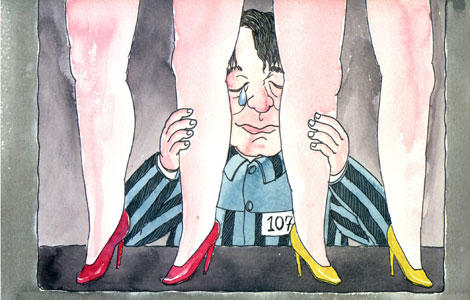Looking to find, feed new food consumers
Updated: 2013-07-23 07:19
By Yao Jing and Ding Qingfen in Zhucheng, Shandong (China Daily)
|
|||||||||||

Agricultural firms step up their efforts to export higher value-added products instead of cheap produce, report Yao Jing and Ding Qingfen in Zhucheng, Shandong
In the spacious workshop of Zhucheng Waimao Co Ltd, a poultry producing and processing company in Shandong province, workers wearing white overalls and masks were cleaning, cutting and packaging chickens. The rumble of machines meant voices had to be raised when people spoke.
All of the chickens being processed were transported from nearby feeding farms managed and owned by the company. The modern production line looks clean and efficient.
This has changed a lot compared with several years ago when the company was more like a farm and was buying chickens from scattered peasant households who could not guarantee the quality of their chickens and other animals.
"We have invested more than 20 million yuan ($3.26 million) in establishing an experimental plant to push innovation and ensure the quality and safety of our poultry products," said Wang Jinyou, general manager of Zhucheng Waimao.
Wang's 38-year-old company is just one of the numerous Chinese agricultural producers that are struggling to move up the value chain against the background of the country's determination to upgrade and transform its foreign trade.
One of the most important improvements for China's agriculture exporters is from selling cheap fresh products to processed goods tagged with higher prices.
Japan, which is known for its strict regulations over imported agriculture products, accounts for 70 percent of Zhucheng Waimao's total food exports.
"All of our products shipped to Japan have passed quality tests since 2008," said Wang.

Right now, Wang is planning to develop new cooked products based on different tastes and cooking methods. In the meantime, he will raise the price of existing new products.
Large packages will also be adjusted to offer smaller ones, such as shrinking one bag of fried chicken from 300 grams to 160 grams, to meet local customers' demands. In order to cater to the elderly in Japan, Wang will launch softer products that are more easy to chew.
Wang is also trying to switch to the Chinese market. "The key factor for expanding in the domestic market is cultivating our brand names. Although we were not previously paying attention to the Chinese market, we are now realizing it has great potential," he said.
Today, the China market accounts for 70 percent of Wang's total sales in quantity. However, as for its business value, China is worth just 40 percent.
Another high-yielding Chinese agricultural product, garlic, which totaled $1.69 billion in exports in 2012, is also taking off after production was upgraded.
In Pizhou in East China's Jiangsu province, the garlic planting area is about 467 million square meters. There are nearly 500,000 garlic farmers. Garlic exports from there account for 10 percent of China's total exports of the root. In recent years, 36 companies have begun to conduct garlic-processing businesses, with five engaging in extended processing.
Local government and companies have invested 200 million yuan in garlic innovation and brand building. New products made using better technology include garlic oil, allicin, an organosulfur compound obtained from garlic, and garlic capsules.
"Ten tons of garlic can produce one ton of allicin with a purity of 10 percent. The value of the garlic used will surge nearly tenfold to 200,000 yuan," said Du Feilong, deputy director-general at Pizhou Bureau of Commerce.
Garlic cloves will become the main exporting product among extended processing products.
"The export of garlic cloves is 8,000 to 10,000 tons every year, which accounts for 10 percent of our total garlic output every year," said Du.
However, the overall agricultural foreign trade has its problems, with China's trade deficit in the sector widening since 2004 as it relies more on imports.
In general, the country's total agricultural trading volume, including fish and forestry, reached $205.5 billion in 2012, up 9.3 percent from 2011. Nonetheless, the trade deficit in agriculture expanded to $56 billion, up 20 percent compared with 2011, according to a China Agricultural Trade Report in 2012 released by the United States Department of Agriculture Foreign Agricultural Service.
Faced with deteriorating trade conditions, such as the appreciation of the yuan, concerns over food safety and pollution in China as well as trade friction, farm exporters are trying to figure out a smooth path to avoid decreasing export volumes.
"Overall agricultural exports remain small and the added value of products is still low. For a long time, Chinese agricultural exporters have been pursuing short-term benefits, which has resulted in cutthroat competition," said Huang Guiheng, manager of Bric Global Agricultural Consultants.
"Although companies are realizing the problem and beginning to pay attention to research and innovation, it will take a long time to make advances in technology and risk management to form a solid basis to contend against international fluctuations and challenges," said Huang.
Huang said Chinese poultry producers have made progress in developing new products and finding multi-marketing channels in foreign trade. But they are still vulnerable because they are short of core technology.
Zhucheng Waimao is worrying about shrinking profit margins in exports in the next half of this year.
"With Japan's currency devaluation, Japanese buyers we signed orders with after March have asked for a reduction in price of 3 to 5 percent," said Wang. Wang's company receives orders in advance of just three to six months, so the business was not affected in the first five months of this year.
In fact, all of its products are dollar-denominated to fend off risks of floating exchange rates. But because its main market is in Japan, it has had to compromise this time.
Higher threshold
Further, bad impressions about Chinese food have led to a higher threshold for goods shipped from China.
"From 2008 to May this year, Japan has randomly checked 15,500 samples of our products. We have to pay 50,000 yen ($500) for each sample testing," he said.
In Japan, the sampling rate of Chinese products is fivefold compared with products from the US, according to Wang.
However, four products in every 10,000 Chinese food catalogs inspected by Japan's quality authorities failed Japanese standards last year, while the ratio for the US was six for every 10,000," Wang said, quoting information from Japan-based CGC, a chain of 220 companies and more than 3,000 stores.
The Japanese authorities will test for residues in processed foods that do not have specific provisional maximum levels for 758 chemicals used in agriculture, based on the concentration in the ingredients, according to the country's Food Sanitation Law.
Nonetheless, Japan, which accounts for 17.7 percent of China's total agricultural exports, was China's largest export market for the sector last year. Top export commodities included chicken, eels and frozen fish fillets, according to the US Department of Agriculture.
"As China's agriculture export destination is relatively concentrated to specific countries, such as Japan and South Korea, it is easy for a floating exchange rate to affect trade performance. Further, some of the countries are erecting trade barriers to protect their domestic production," said Wang Xiaoyue, a senior analyst with Beijing Orient Agribusiness Consultant Ltd, an agriculture and food business consulting company.
"Further transformation for these producers may still take place regarding developing diversified products, building brands and tapping into the domestic market," said Wang.
However, unlike Wang's poultry company, producers of agricultural commodities, such as garlic, are spending much more on research and development to add more value to raw materials.
In Pizhou, endeavors have been made in this area, but fresh garlic in cold storage still makes up most of the exports.
Local garlic producers may go through a tough year because of oversupply of the product and yuan appreciation.
"In China, the output of garlic increased more than 1 million tons from last year but demand from international markets has not climbed. The prospects for this year are not that optimistic," said Du.
"From January to May this year, the export of garlic totaled $100 million, a decrease compared with the same period in 2012," said Du.
Garlic prices for this year are still unclear because the peak season for acquisition and exporting is in July and August, but Du said the increased output has added to a declining price of garlic this year.
Further, the main export countries of Pizhou garlic are Japan, South Korea and Southeast Asia nations.
"But India, Pakistan and other countries are imposing import quotas for garlic to protect their domestic production," said Du.
"Chinese garlic producers have made great strides and have achieved some progress. But it will be a long time before local companies developing competitive and sophisticated products can get their feet on the international stage," said Huang.
Contact the writers at yaojing@chinadaily.com.cn and dingqingfen@chinadaily.com.cn.
(China Daily 07/23/2013 page13)
Today's Top News
UK, Ireland join forces to lure more Chinese visitors
Chinese police question employee of AstraZeneca
Quake in NW China kills 89, injures 700
Kate gives birth to a baby boy
New visas to boost family reunions
Huawei launches mobile app contest in EU
China to implement stricter air quality controls
China's FX purchases decline
Hot Topics
Lunar probe , China growth forecasts, Emission rules get tougher, China seen through 'colored lens', International board,
Editor's Picks

|

|

|

|

|

|





